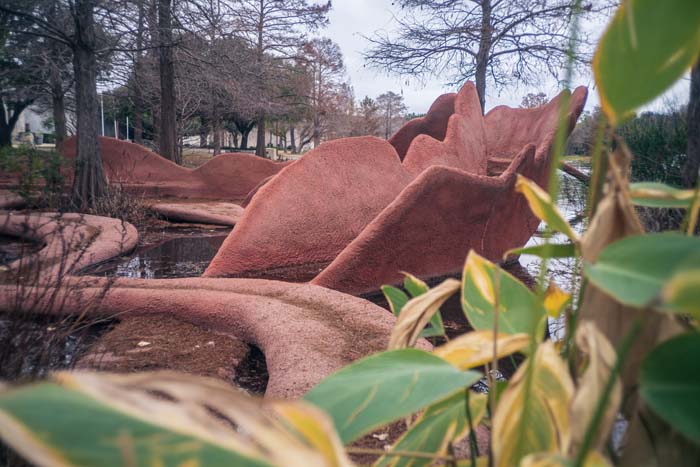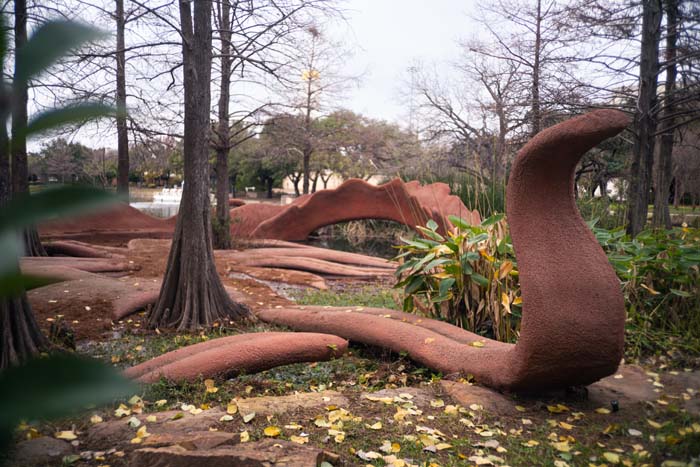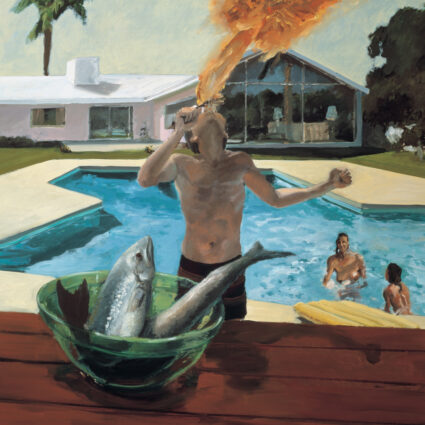Artist Trey Burns on the Fair Park Lagoon, an iconic, yet overlooked, land art work by Patricia Johanson in Dallas, Texas.

Patricia Johanson’s Fair Park Lagoon (1981-86) sits unceremoniously at the edge of Fair Park in South Dallas, a bit cracked and faded—cherished by those in the know and mostly ignored by the commercially minded stewards of the park. Its tentacular mass of burgundy gunite splays out tongue-like and labial, carving its place at opposite ends of a clip-art pond.
The lagoon and the Fair Park we know today are the leftovers of the 1936 Texas Centennial Exposition, when it was given its spectacular and iconic Art Deco face by architect George Dahl. Beyond the fresco murals, ornate sculptures, and buildings that I like to describe as “fascist gingerbreads,” Dahl set the idyllic Leonhardt Lagoon for visitors to rest after perusing the stimulating offerings of the Exposition. In the early 1980s, after almost fifty years of maintaining the landscaping, fertilizer runoff caused a toxic algae bloom, rendering the water feature a noxious bog devoid of fish and plant life.
Enter Harry S. Parker III, then director of the Dallas Museum of Fine Arts, housed in a building next to the lagoon. Beyond offending his sensibilities (a Brooks Brothers aristocrat), this swamp had become an eyesore at the front of his fledgling museum. After Parker saw Patricia Johanson’s drawings at a gallery in New York, he called her up to suggest she create one of her “bioremediation” interventions to save the pond. Johanson methodically set out to resurrect the ecology, ostensibly engineering a wetland, and after years of fundraising and planning the work was finally realized in 1986.
The form of Johanson’s work is drawn from two native Texas plants, the Texas fern (Pteris multifida) and the delta duck-potato (Sagittaria platyphylla). The interwoven arms of the sculpture provide a series of microhabitats for planted flora—from bulrushes and wild rice along the shore to floating and submerged plants in the water. Fish, turtles, and ducks were all introduced to establish and support a healthy ecological system. The resultant sculpture lands somewhere between the feeling of visiting a nature preserve and a Putt-Putt golf course.

Fair Park is also home to the annual Texas State Fair, which I recently visited, swimming upstream through corridors of churning electric wow, in search of a fabled deep-fried pecan pie (served à la mode). I lingered for a moment watching the airbrush-t-shirt-stand artist emblazon the name Michelle with drop shadow across the hazy sunset skyline of Dallas. Nearby, the #TruckZone, part of the fair’s auto show, displayed the latest absurd offerings, their cartoonish scale set among fake rocks and mountain scenes, frozen in their prowess like Roman statuary. One scene placed a Ford truck unironically on top of an oil derrick, another truck climbing up the side to apparently make a challenge as king of the gas guzzlers. We pushed deeper through a parade of turkey legs, Cowboys jerseys, and sloshing frozen drink cups to find the Johanson work surrounded by temporary fencing.
The lagoon was quiet, and the chain link made it feel like a world apart—a porous boundary between two swampy realities. The fence was there to keep revelers out of the biome and most likely protect imbibing patrons from falling in. It startled me to see it caged off, but I appreciated a momentary clarity. Johanson’s work holds much more than native flora and tranquil respite; it protects a blueprint for an imperiled future.





